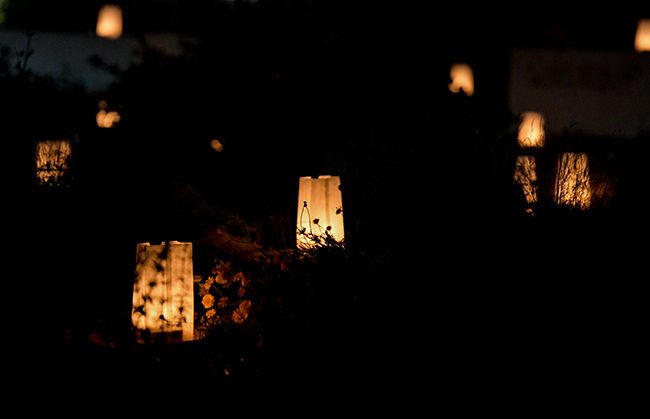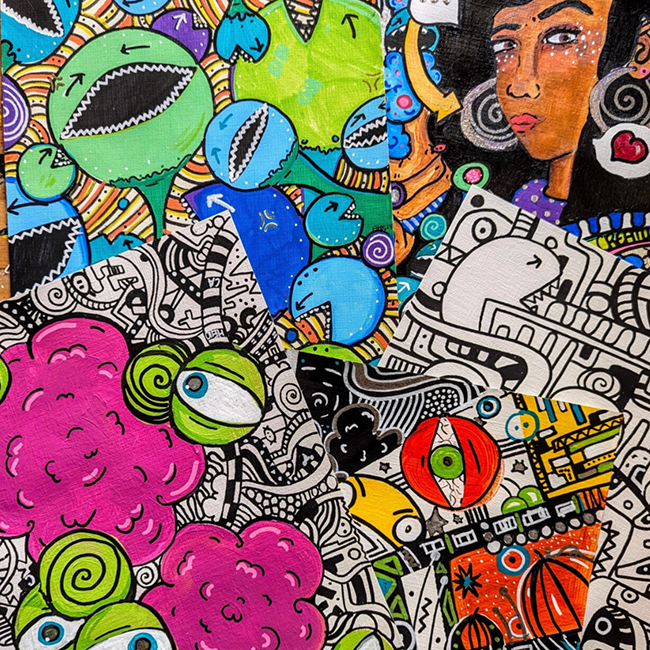Sharing good times with a laugh
When Claremont High School art teacher Tamara Kirkpatrick decided to bring a working artist to class to speak to her second- and third-year art students, she didn’t mess around. With the help of Mrs. Nelson’s Toy and Bookshop in La Verne, she managed to nab Harry Bliss, an artist and nationally syndicated cartoonist whose work has graced the New Yorker and the Los Angeles Times.
Mr. Bliss, who is also known for a number of children’s books nearing iconic status, including a popular series following an irrepressible dog named Bailey, is on the West Coast promoting his latest release, Bailey at the Museum.
Mr. Bliss delivered an engaging presentation accompanied by slides, with topics ranging from his myriad influences to his work for publications like the prestigious New Yorker. For the eager but still-developing artists of Ms. Kirkpatrick’s art production and AP art studio class, the talk represented a short but dense education in a number of artists whose impact has been felt in the world of fine art and popular culture.
Mr. Bliss began by talking about his childhood, which made his avocation nearly inevitable. The son of 2 artists, he hails from a family where nearly everyone, from his uncles to his sister, makes art for a living.
“I grew up in a house where, if you couldn’t tell the difference between a Brach and a Picasso, you were beaten,” he joked. It’s not much of an exaggeration, he said, sharing a photograph of his parents’ Vermont home, the living room embellished with wall-to-wall art in an array of styles, subject matter and media.
In this culture-drenched atmosphere, Mr. Bliss embarked on a period of self-education, poring over the works in museums, books and comics. He took the time to discuss many of his favorite artists and works, sharing the earliest mélange of images and ideas that helped fuel his vision.
Mr. Bliss loved vibrantly illustrated children’s books, from whimsical fare like P.D. Eastman’s 1961 classic Go Dog Go to darker offerings like Maurice Sendak’s In the Night Kitchen.
“That was a huge influence on me when I was growing up. It’s very dramatic, very surreal, even more so than Where the Wild Things Are,” he said. Later, Mr. Bliss shared a photograph of himself and the legendary author and artist, taken at Mr. Sendak’s home before his death this past May. The snapshot memorialized just one of the many lifelong dreams he has been able to fulfill thanks to his success.
From an early age, art touched with a bit of darkness resonated with Mr. Bliss, whose work is often infused with irreverence and cynicism. As an example, he shared a cartoon he created featuring a spoof character called “Way Too Curious George.” In his rendition, the loveable monkey comes face-to-face with a bunny. “I wonder what it feels like to kill?” Mr. Bliss noted that, as a boy, he loved the macabre line drawings of Edward Gorey as well as monsters, those depicted by Frank Frazetta on the cover of magazines like Creepy and Eerie, and in the movies.
“My brother and I watched a lot of television,” he said somewhat apologetically. “I know it’s not cool to say that in school.”
Later, he would be able to channel these influences into his work, including an exuberant New Yorker cover from August 2005 where King Kong uses a Super Soaker water gun to drench the sweltering denizens of New York.
On closer examination, he notes, even his ostensibly wholesome childhood favorites like Charles Schulz’ Peanuts Gang exude melancholy.
“Charlie Brown is a depressing kid. He’s not a happy camper,” Mr. Bliss said. “[Schulz’] humor has some real struggle, borderline tragedy.”
Hearing him talk, it became quickly apparent that the starting point for any artist is intense fandom. The next step is hard work.
Mr. Bliss attended art school in the 1980s, living the starving student cliché, sustained by a daily diet of Ramen noodles and hot dogs. There, he immersed himself in the pursuit of life drawing.
“If you want to be an artist, you must draw the human figure,” he said, noting that you get past the giggly phase quickly. “When you draw nudes, you appreciate how amazing the human body is when the light hits it.”
Mr. Bliss worked in the restaurant business for 17 years before he became able to sustain himself through art, proof positive that persistence is the essence of success. The artist, who shared with the students that he has a 19-year-old son, “so I know your shenanigans,” works steadily from 9 a.m. to 3 p.m. each day without a break.
For his cartoons, he uses a graphite pencil in a special holder and a kneaded eraser first. He inks the drawings then picks up the pencil again to shade the images. For his color drawings, Mr. Bliss prefers to use a combination of black ink and watercolors.
While he has had many striking covers published in the New Yorker, many of the images he considers among his finest have been ultimately discarded in favor of other artists’ submissions. Getting established as a New Yorker panel cartoonist proved even tougher than landing on the cover. He initially went through an almost hazing-like period when cartoon after cartoon he submitted was rejected.
Mr. Bliss shared a photo of a pile of cartoons submitted to the New Yorker, representing just one batch churned out by hopeful regular contributors. The storied magazine gets 1000 cartoons a week, and buys only 15, he said.
The class went by all-too-quickly for the students and Mr. Bliss, who didn’t have time to use the easel he had set up so he could make sketches for the class. He stayed a few minutes afterwards, answering questions and signing the copies of his new Bailey book some students purchased.
Ms. Kirkpatrick said she was very pleased with Mr. Bliss’ presentation.
“I found it really interesting. I hope the kids are able to make some connections and see how they can use art in the future to become working artists,” she said.
Eleventh grader Ashlyn Jackson said she was glad her teacher arranged for the lecture, which was “illuminating.”
“I thought it was really good. I like that he showed what he has done and other people’s work,” she said. “I wish I could have seen him draw something, though.”
—Sarah Torribio
storribio@claremont-courier.com










0 Comments